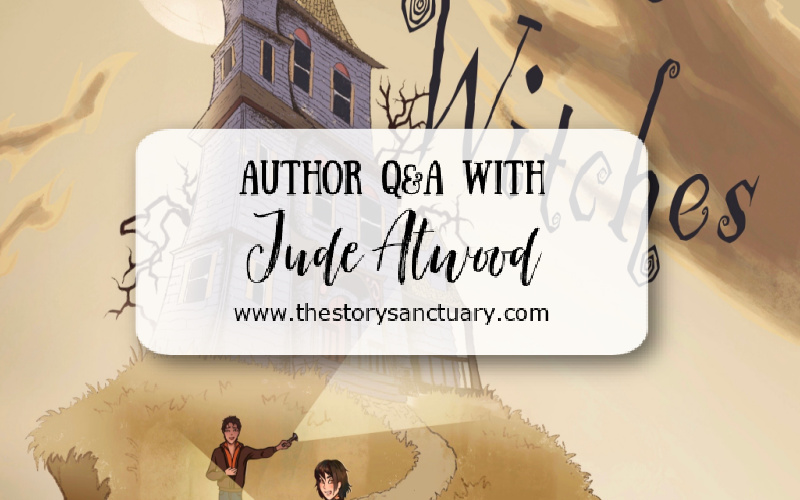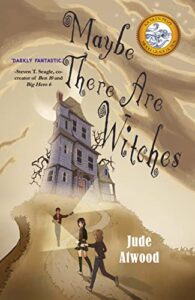I recently learned about a middle grade book called MAYBE THERE ARE WITCHES. In the book, a girl learns an ancestor of hers was hanged for being a witch. She finds her great-great-great-grandmother’s diary in the basement. Bad things start happening around her, things predicted in the diary. I’m generally a fan of intergenerational stories, so I’m super intrigued by this setup. When I learned author Jude Atwood was available to answer some questions about the book, I couldn’t resist hosting a Q&A. Here’s what I learned.
I find that a story was often inspired by a question. Was there a question that inspired you to write MAYBE THERE ARE WITCHES?
I think a lot of writing decisions are inspired by questions. For me, these questions often take the form of “What if?” I keep a lot of lists, and the seed that would become MAYBE THERE ARE WITCHES was in a list, years ago, of ideas for horror movie scenes. It was something like, “What if a woman found a very old diary in her house, and as she read it, she realized it was written to her?” Later, as I started thinking about writing a novel, I thought, “What if the woman was a girl? What if the book was written by an ancestor of hers?”
It looks like the story is set in rural Illinois. What is it about that setting that makes it perfect for your book?
I grew up on a farm in rural Illinois. Since then, I’ve lived in small cities like Peoria, Illinois, and bigger cities, like Portland, Oregon, and Los Angeles. Now I live in Orange County, where multiple cities form a sort of suburban megalopolis. There are plenty of things to love about all of these places, but I’m fascinated by their differences, and the misconceptions we often have about other regions. For example, where I grew up, I never skipped school, because even if I’d wanted to, there was no place to go—anywhere I went, whoever I saw would have said, “Jude, why aren’t you in school?” On the other hand, many of the college students I work with in Orange County have wild stories about skipping high school, even though some have never left the state.
I wanted to write about a girl who moves from Orange County to rural Illinois, so she can undergo a bit of a culture shock, but can also go through the very human experience of trying to find a sense of community in a new place, trying to figure out who “gets” you, and who you can trust and open up to.
For a writer, there are also practical reasons to choose a setting with a small population, especially for a scary story or a mystery. It’s easier to keep track of a limited group of characters, and there’s more of a sense that you can’t get away.
Who is your favorite character? Are there things about your favorite character which couldn’t be included in MAYBE THERE ARE WITCHES?
My official position is that I love all of my characters equally. And the easy answer is that I love whoever I’m writing at the time. But if I had to pick one, I’ll say that I really loved trying to work out the character of Chris Beck, who begins the story as a sort of backwoods loner who marches to the beat of his own drum.
The book was pared down quite a bit during the editing process, because my editor and I wanted to focus on the supernatural mystery elements of the story. Chris lost a few good lines, but not as many as the adult characters did.
Is there a scene or moment in your novel that really sticks with you? Can you tell us a little bit about it?
There’s a scene in the first half of the novel where two of the main characters, Clara and Gary, visit Chris’ house for the first time. He takes them to the basement to show them a dead coyote in his family’s chest freezer. When I was writing it, I thought of it as a funny, if slightly odd, scene, but I’ve since had a conversation with a blogger who thought the idea seemed too over-the-top/gory for a middle-grade book. That surprised me, because it came straight out of my childhood. We often had some kind of wild animal in our freezer, either for a bounty or for food.
My life’s a little different today. Now my freezer just has a bag of ice, a frozen pizza, and some blueberries and bananas for smoothies.
What was your favorite part of the process of creating MAYBE THERE ARE WITCHES? What was the most fun?
I’m a fairly slow writer, probably because I’m enamored with all of the aspects of writing a novel that don’t involve actually writing. I love to brainstorm ideas, and jokes, and scenarios—stuff that I may or may not use. As I mentioned earlier: I keep a lot of lists. I also really like doing research. The main characters in this book compete on their middle school scholastic bowl team, and as I researched, I learned that scholastic bowl has changed a bit since I competed years ago; the questions now have a very specific structure. So I got a kick out of trying to create a whole packet of potential scholastic bowl questions that might sound realistic, even though only a few ended up in the book.
What do you most hope that readers take away from your book?
It’s a story with a witch and a villain—although they may not be the same person. But it’s also a story about the stages of friendship, and the ways that we try to understand the people we meet as we get to know them better. I hope the book inspires a few readers to think about how there’s more to everyone than what we think we know.
What is one question about your novel you are often asked by readers?
The question I get asked most often is, “Are there witches?” But that’s probably because many of my early readers have corny senses of humor.
About Maybe There Are Witches
Amazon | Bookshop | Goodreads | My Review
“I can’t think of a better fate for young readers.” -Steven T. Seagle, co-creator of Ben 10, Big Hero 6, and Camp Midnight
After moving to the tiny village of Biskopskulla, middle school student Clara Hutchins discovers that her family has a history in the region: one hundred forty years ago, one of her ancestors was hanged as a witch from the white oak tree on the edge of town. When Clara finds a mildewed diary in the basement, she’ s even able to read the rambling thoughts of her long-dead relative.
But when the book’ s predictions about Clara’ s own life start coming true, she wonders if those 19th-century villagers had a point: maybe her great-great-great grandmother really did have unearthly abilities. Now, a break-in at the tomb of the town’ s founder means a great evil has returned to Biskopskulla. Clara and her newest friends— two of the weirdest boys in school— must join forces to decipher the messages of a murdered witch and stop an unnatural catastrophe. But as they quest through historic cemeteries, backcountry libraries, and high-octane scholastic bowl tournaments, something sinister is lurking, watching, and waiting…
About Jude Atwood
Facebook | Instagram | Twitter | Website
Raised on a farm in rural Illinois near the Quad Cities, Jude Atwood treasured the long drives into town for groceries and library books. The small towns in the region were brimming with opportunities for kids to be creative. The library hosted poster contests; the newspaper had a kids’ cooking feature. Once, Jude took youth summer classes in Parody, Movie Appreciation, and Latex Mask-making at the local community college. He wrote songs about garbage bags, learned about Alfred Hitchcock, and made a shrunken head.
He got his first job at fifteen: detasseling, pulling the reproductive parts off of corn plants for a seed corn company making hybrid varieties of corn. At Bradley University in Peoria, Illinois, Jude competed in intercollegiate forensics, where he learned the value of a well-timed joke and the fact that your audience always has something to teach you. He moved to Orange County, California, where it hasn’t snowed in over seventy years, and earned his M.F.A. in Film from Chapman University. In Hollywood, he worked very briefly as an assistant in the office of a man who is now famous for throwing things at assistants.
After that, Jude became a full-time community college professor, a vocation that continues to this day. He spent several years coaching the college speech, debate, & theater team, and he now devotes much of his energy to teaching mass communication and media literacy classes. He’s made many friends and (he hopes) very few enemies. In his career as an educator, Jude received a commendation from the city of Santa Ana for his work with students, and was honored with the Legacy Award from the American Readers Theater Association for contributions to the art of readers theater. His writing has appeared in Unfortunately, Literary Magazine and Plainsongs, and his first novel, Maybe There Are Witches, won the 2021 Kraken Book Prize for Middle Grade Fiction.
Jude lives in California with his boyfriend and his dog.


















Interesting interview, added to my TBR
Great interview! The book cover is really nice 🙂